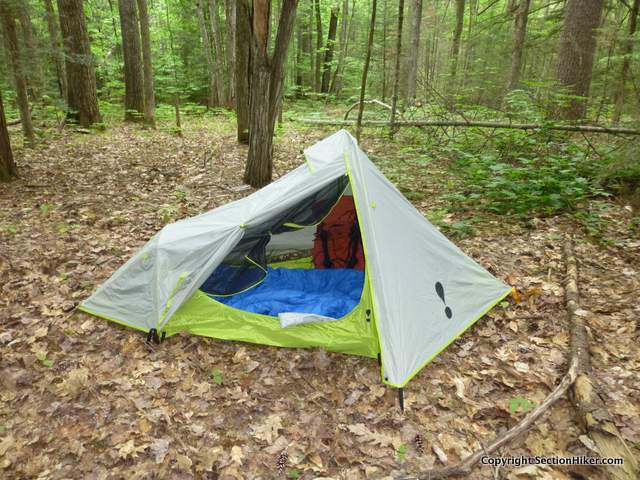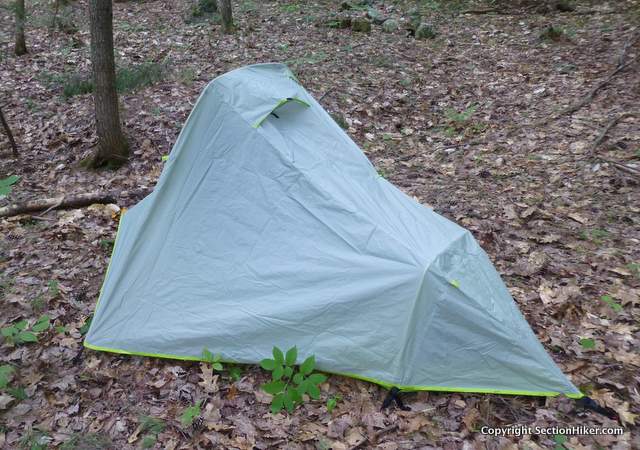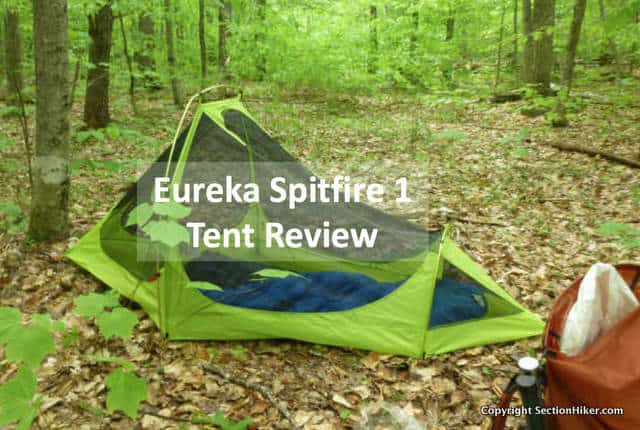The Eureka Spitfire 1 Tent is a low-cost, lightweight, and durable double-wall camping and backpacking tent that weighs 2 lbs 12 oz. Easy-to-setup, this classic hoop-style shelter has plenty of interior room to sit up inside, change your clothes, or store essential gear. Complete with durable aluminum poles, the Spitfire provides plenty of wind and rain protection with an abundance of interior mesh for good ventilation. If price is a priority, but you want to get a quality product that is going to work well and last for years, the Spitfire 1 is a top pick.
Specs at a Glance
- Type: Double wall
- Doors: 1 side door
- Weight: 2 lbs 12 oz (confirmed)
- Inner Tent: 18.5 oz
- Rainfly: 16.6 oz
- Aluminum Poles (2): 8.9 oz
- Inner Tent Dimensions: 100″ long, 42″ wide at the chest, narrowing to 24″ wide at foot. Due to the diamond shape, the tent is best used by people who are 72″ tall or less.
- Maximum pole segment length: 19.5 inches
- Minimum number of stakes to pitch: 4, although I’d recommend using 6-8 for maximum tautness.
- Maximum pole segment length: 19.5 inches
- Materials:
- 75D polyester taffeta fly (1800mm)
- 40D Polyester no-see-um
- 75D polyester taffeta floor (1800mm)
Inner Tent
The Spitfire 1 has a diamond-shaped inner tent that has a deep bathtub tub floor suitable for camping on wet ground. The inner tent is suspended from two hoop-style aluminum poles that fit into side grommets and staked at the head and foot end. When purchasing inexpensive tents, it’s always important to get a tent with aluminum poles and not fiberglass ones, which break very easily. The Aluminum DAC poles provided with the Spitfire are much more durable.
While the inner tent is 100″ in length, the pointed ends are two narrow to lay in. The effective floor dimensions are closer to 72″ long x 39″ high x (42″ wide at the chest, tapering to 24″ wide) at the feet. In other words, the tent is best used for people who are 6′ tall or less, while the pointed ends are still quite good for gear storage.

In addition to the abundant side-wall mesh, there are mesh panels situated near the feet to help keep the foot end of your sleeping bag or quilt dry, or dry out wet shoes if you stash them here at night. The amount of ventilation is quite nice, particularly when you can roll back the rain fly and let the wind blow through the side walls unfettered.
There are side mesh pockets along the inner support walls to hold valuables. The inner tent also has a zipper in the roof, so you can reach open or close a roof vent in the rain fly without having to get out of the inner tent to do so.
The inner tent has one zippered side door, with a long J-shaped zipper that provides easy entry and exit. The mesh side door can also be rolled up and secured if insect protection is not an issue.

Rain Fly
The Spitfire rain fly drapes over the inner tents aluminum hoops and secures to its corners using durable plastic buckles. The head end is color-coded, so you can orient the fly in the right direction without having to think too much. Two stakes are needed to secure the vestibule door and the opposite side of the tent to the ground while velcro loops on the underside of the fly can be used to secure the fly to the hoop poles. There are also additional guy out points on the fly to stake down the tent in very windy weather, but you’ll need to supply your own reflective cord to guy them out.
The Spitfire 1 has one vestibule on the door side, which is quite narrow and difficult to store gear in because it blocks the side door. If your pack is fairly empty, you can scoot it into the narrow space behind the door as shown. You can also compensate for this lack of vestibule storage by unloading keeping gear in the triangular head and foot end of the inner tent, or even alongside you in the tent because it’s so wide. While there is a second covered space on the opposite side from the door, it’s not reachable from inside the inner tent. Adding a zipper there or a “closet-style” pass-through, like those found on some Sierra Designs tents, would make that space a lot more functional.

One place where the rain fly does shine is the top vent, which can be propped open or closed from inside the inner tent. It is ideal for venting the warm air that accumulates inside the tent (since it rises) and is the leading cause of internal condensation.
Honestly, it’s difficult to get a super taut pitch with the Spitfire 1 rain fly because the fabric doesn’t have much stretch, like the lighter weight fabrics you’ll find on more expensive tents. The buckle tensioners and webbing can’t be pulled tight enough and the overall shape of the tent requires a uniformly flat pitching surface that you’ll be more likely to find in a campground than at a wild, off-trail trail site. If you’re willing to ignore these pitch aesthetics, the rain fly will still protect you in heavy rain and wind, even if it’s not the prettiest looking rain fly you’ve ever seen. The aluminum poles are plenty strong to maintain the structure of the tent, provided you stake it out completely before a storm.

Recommendation
The Eureka Spitfire 1 is a surprisingly good value for a one-person backpacking tent. It weighs just 2 lbs 12 oz and has durable aluminum poles, a spacious interior with excellent ventilation, and it’s easy to set up. While it’s quite long on paper, it’s best used by someone who’s 6 feet or less in height because the diamond-shaped interior isn’t completely usable as sleeping space. If that’s not a limitation, but the cost is, you’ll have a hard time buying a tent that’s as good at the Spitfire at a comparable price. It really is a great value, perfect for the occasional backpacker or scout.
The author purchased this product.
SectionHiker is reader-supported. We only make money if you purchase a product through our affiliate links. Help us continue to test and write unsponsored and independent gear reviews, beginner FAQs, and free hiking guides. SectionHiker.com Backpacking Gear Reviews and FAQs
SectionHiker.com Backpacking Gear Reviews and FAQs 
Still love my Spitfire! Can’t do much better unless you spend 3-4 times the price. I’m 5’7″, so I fit perfectly in the tent. If you’re much more than 5’10”, it might be a bit of a tight squeeze. For me, it was money well spent.
THANK YOU! As a boy scout leader I am always looking for inexpensive lightweight gear and reviews on them can be hard to find. I appreciate you including less expensive practical options.
This is a great Scout tent!
Not specific to this tent but is there any information regarding how much having a roof vent helps with condensation? I have wondered why a vent like this couldn’t be incorporated into single wall tents where condensation is much more of a problem. It seems like it would (the warm, moist air from your breath rising up and out thru the vent plus offering more air flow in general) but maybe it doesn’t work this way?
That’s exactly how it works – warm air carrying water vapor rises.
Many single wall tents *already* have this feature – a peak window of some sort, or enough mesh and ground clearance that it’s effectively redundant.
Nice compilation. I read lists like this with interest for the day my BA Flycreek UL2 (used solo) might develop some fatal problem. Still good after many years of use, and at 2 pounds, 8 ounces for tent, fly, stakes, and groundcloth, i’m not yet moved to fix something that isn’t broken. And to think when i first started out backpacking, i was lugging a multi-person (3?) Eureka A-frame that was north of nine pounds.
Not sure how an actual study might be put together, but i’d also like to see some real information on the effectiveness of these tiny fly roof vents. My semi-reasoned bet is that they do something close to nothing. If one considers the amount of moisture-laden, warm air moving through most of the entire area of inner tent, much of it is going to contact the inner surface of the fly pretty much everywhere near the ridge area, where the moisture will condense. I’d think the percentage of moist air that manages to escape through a few square inches of vent would be minimal compares to what contacts the rest of the fly.
Oops, this was meant for the 10-best one-person tents post.
For those willing to carry a couple extra pounds, and bring all their gear inside, a Spitfire 2 is worth considering. I have slept in mine during thunderstorms, with hail and 40mph winds. Everything stayed dry and I was very comfortable with all the extra space. The spitfire tents are a great value.
In my opinion. the Spitfire 1 is best “bang for your buck” starter tent. I purchased mine about 4 years at Dick’s Sporting Goods for only $69.99 during a weekend Camp Gear Sale. I used it multiple occasions on weekend hiking and car camping trips. Its very easy to pitch. Spacious enough to store all gear (using the head and foot areas) and my 5’10” frame. Peak height is plenty tall enough to sit up straight and change clothing or packing pack. Vestibule (zipper side) is great for wet (and potentially muddy shoes) and could easily keep pack dry and out of the weather if choosing to store outside. After several raining nights, I always stayed dry. Small roof vent seemed to be a useless novelty but surprisedly it really seemed to funnel out moist air or direct a soothing cool summer breeze downward. Dropping pack weight, I replaced my Spitfire with a used SMD Scout and later, a Lunar Solo (my favorite… for now) but I kept the Spitfire for car camping or loaning to fellow hikers. Tip: change out the stakes for lighter options to reduce carry weight.
One thing to note is that the Eureka Spitfire 2 *does* have 2 doors, so the vestibule is accessible on both sides of the tent. Although it is heavier at 4 lbs 3 oz.
I own both models, using the Spitfire 1 primarily for solo backpacking, and the Spitfire 2 for car camping or trips with my partner.
At 5’9″ I do feel like I’m pushing the limits of the Spitfire 1’s length, but have plenty of room on the sides to store boots and personal items. Plus the sloped design allows me to sit up comfortably inside without feeling claustrophobic.
I’ve had mine for 7 years now and it is still serving me well!
I see Eureka doesn’t make this tent anymore. That’s too bad. I borrowed one for 2 nights and I liked it a lot. With just 4 stakes and that 70D material, it’s a bomber tent. If they made it out of 15D instead, they could get the weight down to about 2 lbs.
Wow. Looks like it’s discontinued on their website. Although there is probably so much inventory out in retailers that you’ll probably be able to buy it for years to come.
I have had this tent for over 5 years and have taken it on many great adventures. If there is a question about durability, I can tell you this is very well made… regardless of cost, this is not a “cheap” tent. The only negative is that the rain fly is a bit heavy for something I have almost never needed (I live in Arizona), yet have taken on every trip. And you definitely want to use all the guy out points to keep it from flapping in heavy wind. Other than that, this is really a great tent that has, for me, withstood the test of time. For the price, I dont think you can beat it as a 1-person shelter.
BTW, I just took mine out to check the stakes and I can reiterate that the tent is still in fantastic condition even after all these years and trips… best money I have spent on a tent!
Andrew
Unfortunately, Eureka stopped making it. Hold onto yours!
I own the Spitfire. I purchased it from The Scout Shop in Canada, and I’m very satisfied with it. It’s one of those very tight small tents that you’re not going to fit much gear in so it’s important to bring rain gear to cover your pack, as most of us that use this tent store out packs outside. The vestibule really only provides enough space for a jacket and shoes and maybe enough shelter to cook under with a small single burner stove if rained in for extended periods.
I love this tent for the ability to sit up and read and to be able to still have good double walled low moisture sheltering, with Eurekas’ great waterproof materials that it’s famously trusted for!
I am 6’2 and weigh 247 lbs. I fit okay in this tent, but if you’re much taller than I am It would be a tighter fit. I tend to be a bit tight at the foot box end of this tent. But I don’t move much in my mummy sleeping bag so it’s not a big concern. If you move around a lot, while you sleep then this may not be the tent for you.
Overall I agree with this assessment, except for the height restriction. So I figured I’d pipe up as I’m considerably taller and use the Spitfire 1 with ease! I love it in bad weather! If weather is perfect I will sometimes use a tyvek bivy instead.
If you’re taller and wider than I am I would recommend going to something like The Six Moons Designs Lunar Solo. It provides a bit more interior living space, and you can store your bag in the tent.
Good solid review. I’ve used this tent in some pretty drastic high winds and very rainy weather. When many others are soaked, this tent has always provided me above average protection. Many ultralite people may cut it up for the extra pound of weight, but that soon stops when they compare the weather protection in bad storms…. it’s superb for extremely bad rain storms, especially if set up head end towards high winds.
The two end pegs will be enough to support the tent with the very tough poles if in rocky environments, even in mild winds up to about 35 to 40 mile an hour winds without having to peg in all pegs if caught in sudden storms. Which provides some “in a pinch” security when trying to get out of rains fast! Just little “learn as you go” features like that make this tent a good choice for those that like to be on the move. I’ve used it while hiking in good distances, while kayaking and canoeing with heavy portages in Northern Ontario Canada, to help limit weight and still get great protection from the elements. It retains heat well on colder days and manages to stay cooler on hot days remarkably enough.
That’s my two cents about this product!
Cheers!